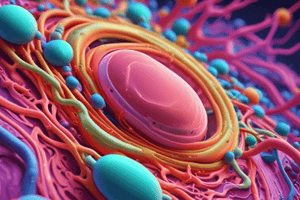Podcast
Questions and Answers
What term describes a plasma membrane's characteristic of allowing certain substances to pass while restricting others?
What term describes a plasma membrane's characteristic of allowing certain substances to pass while restricting others?
Which part of the phospholipid bilayer faces the watery environment of a cell?
Which part of the phospholipid bilayer faces the watery environment of a cell?
What type of transport involves movement from an area of high concentration to an area of low concentration without the need for energy?
What type of transport involves movement from an area of high concentration to an area of low concentration without the need for energy?
What is the outcome when a cell is placed in a hypertonic solution?
What is the outcome when a cell is placed in a hypertonic solution?
Signup and view all the answers
What drives the flow of substances across the plasma membrane?
What drives the flow of substances across the plasma membrane?
Signup and view all the answers
Which solution has a higher concentration of dissolved solutes outside the cell compared to the inside?
Which solution has a higher concentration of dissolved solutes outside the cell compared to the inside?
Signup and view all the answers
What type of diffusion specifically refers to the movement of water across a membrane?
What type of diffusion specifically refers to the movement of water across a membrane?
Signup and view all the answers
What happens to the concentration of solute when equilibrium is reached?
What happens to the concentration of solute when equilibrium is reached?
Signup and view all the answers
What type of transport requires energy to move substances against their concentration gradient?
What type of transport requires energy to move substances against their concentration gradient?
Signup and view all the answers
Which method of transport involves the engulfing of large particles by the cell?
Which method of transport involves the engulfing of large particles by the cell?
Signup and view all the answers
What initiates the conformational change in the sodium-potassium pump?
What initiates the conformational change in the sodium-potassium pump?
Signup and view all the answers
What is the primary role of transport proteins in facilitated diffusion?
What is the primary role of transport proteins in facilitated diffusion?
Signup and view all the answers
Which of the following statements best describes exocytosis?
Which of the following statements best describes exocytosis?
Signup and view all the answers
What is the main function of the sodium-potassium pump?
What is the main function of the sodium-potassium pump?
Signup and view all the answers
Which type of transport is characterized by the absorption of liquids by a cell?
Which type of transport is characterized by the absorption of liquids by a cell?
Signup and view all the answers
What occurs when the sodium-potassium pump expels sodium ions?
What occurs when the sodium-potassium pump expels sodium ions?
Signup and view all the answers
Study Notes
Plasma Membrane Functionality
- Plasma membranes are selectively permeable, controlling what enters and exits the cell.
- Essential for maintaining homeostasis by regulating internal conditions.
Structure of Plasma Membrane
- Composed mainly of phospholipids with a hydrophilic phosphate head and two hydrophobic fatty acid tails.
- The phosphate head is polar and interacts well with water, while fatty acid tails are nonpolar and repel water.
Transport Mechanisms
- Movement of substances is influenced by concentration gradient, polarity, and molecular size.
Passive Transport
- Occurs from high to low concentration without energy expenditure.
- Simple Diffusion: Solutes move down the concentration gradient until equilibrium is achieved.
- Osmosis: Special case of diffusion involving water, moving across the membrane from areas of high water concentration to low.
Tonicity of Solutions
- Isotonic: Equal concentration inside and outside the cell, maintaining cell size.
- Hypertonic: Higher solute concentration outside the cell, causing cell to lose water and shrink.
- Hypotonic: Lower solute concentration outside the cell, leading to water influx and cell swelling.
Facilitated Diffusion
- Involves transport proteins aiding the movement of specific molecules, such as ions and sugars, across the plasma membrane.
Active Transport
- Transports substances from low to high concentration, requiring energy (ATP).
- Utilizes carrier proteins, such as the sodium-potassium pump, to move ions against their concentration gradients.
Bulk Transport
-
Endocytosis: Process of enfolding the plasma membrane to take in large solutes, forming a vacuole.
- Phagocytosis: Engulfs solid particles like bacteria and dead cells.
- Pinocytosis: Involves the uptake of liquids and solutes, common in absorbing cells.
-
Exocytosis: Mechanism for expelling large solutes from the cell by merging vesicles with the plasma membrane.
Studying That Suits You
Use AI to generate personalized quizzes and flashcards to suit your learning preferences.
Related Documents
Description
Explore the essential functions and structure of the plasma membrane in this quiz. Understand how selective permeability and transport mechanisms play a critical role in cellular homeostasis. Delve into passive transport phenomena such as diffusion and osmosis, as well as the concept of tonicity.




